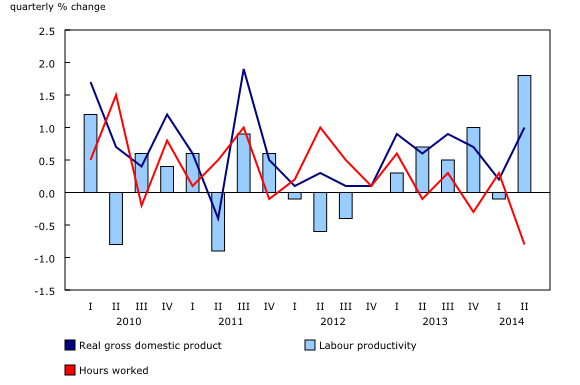Labour productivity, hourly compensation and unit labour cost, second quarter 2014
Archived Content
Information identified as archived is provided for reference, research or recordkeeping purposes. It is not subject to the Government of Canada Web Standards and has not been altered or updated since it was archived. Please "contact us" to request a format other than those available.
Released: 2014-09-05
Labour productivity of Canadian businesses rose 1.8% in the second quarter, after edging down 0.1% in the first quarter.
In the second quarter, businesses increased their output at a much faster pace than in the previous quarter, while hours worked declined, following a quarter of growth. In the first quarter, output and hours worked increased at a comparable rate.
Real gross domestic product (GDP) of businesses rose 1.0% in the second quarter, its highest growth rate since the third quarter of 2011 (+1.9%). In the second quarter, the output of service-producing businesses grew twice as fast as the output of goods-producing businesses, which contrasts with the situation in the first quarter.
Hours worked in the business sector declined 0.8%, after increasing 0.3% in the first quarter. In the second quarter, hours worked fell 1.0% in goods-producing businesses and 0.6% in service-producing businesses. The decline was widespread, with the agricultural sector (-5.9%) registering the largest decrease. Hours worked were unchanged in construction and wholesale trade.
In the second quarter, productivity of both goods-producing businesses (+1.7%) and service-producing businesses (+1.8%) increased at a comparable pace.
With the exception of utilities (-0.2%), all major industry sectors saw productivity gains during the quarter. Retail trade, mining and oil and gas extraction, manufacturing and wholesale trade were the largest contributors to the overall increase in productivity in the second quarter.
In the United States, labour productivity of American businesses rose 0.6% in the second quarter, following a 1.3% decline in the first quarter.
For Canadian businesses, labour costs per unit of production increased 0.3% in the second quarter, one-third of the rate observed in the previous quarter.
Hourly compensation grew 2.0% in the second quarter, slightly faster than labour productivity. For a third consecutive quarter, hourly compensation increased more rapidly in goods-producing businesses (+2.3%) than in service-producing businesses (+1.9%). In the second quarter, hourly compensation was up in all major industry sectors except transportation and warehousing.
After five quarters of depreciation, the average value of the Canadian dollar relative to the American dollar rose 1.2% in the second quarter. Because of the appreciation, Canadian businesses' unit labour costs measured in US dollars were up 1.4%. It was the first increase since the fourth quarter of 2012.
By comparison, American businesses' unit labour costs were unchanged, in the wake of a 3.0% gain the previous quarter.
Note to readers
Revisions
With this release on labour productivity and related measures, data were revised back to the first quarter of 2014 at the aggregate level and to the first quarter of 2013 at the industry level.
Productivity measure
The term "productivity" in this release refers to labour productivity. For the purposes of this analysis, labour productivity and related variables cover the business sector only.
Labour productivity is a measure of real gross domestic product (GDP) per hour worked.
Unit labour cost is defined as the cost of workers' wages and benefits per unit of real GDP.
All the growth rates reported in this release are rounded to one decimal place. They are calculated with index numbers rounded to three decimal places, which are now available on CANSIM.
The System of macroeconomic accounts module, accessible from the Browse by key resource module of our website, features an up-to-date portrait of national and provincial economies and their structure.
Links to other releases from the national accounts can be found in the second quarter 2014 issue of Canadian Economic Accounts Quarterly Review, Vol. 13, no. 2 (Catalogue number13-010-X). This publication will be updated on September 12, at the time of the release of the national balance sheet and financial flow accounts.
Labour productivity, hourly compensation and unit labour cost data for the third quarter will be released on December 5.
Contact information
For more information, or to enquire about the concepts, methods or data quality of this release, contact us (toll-free 1-800-263-1136; 514-283-8300; infostats@statcan.gc.ca) or Media Relations (613-951-4636; statcan.mediahotline-ligneinfomedias.statcan@canada.ca).
- Date modified:


